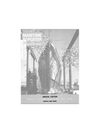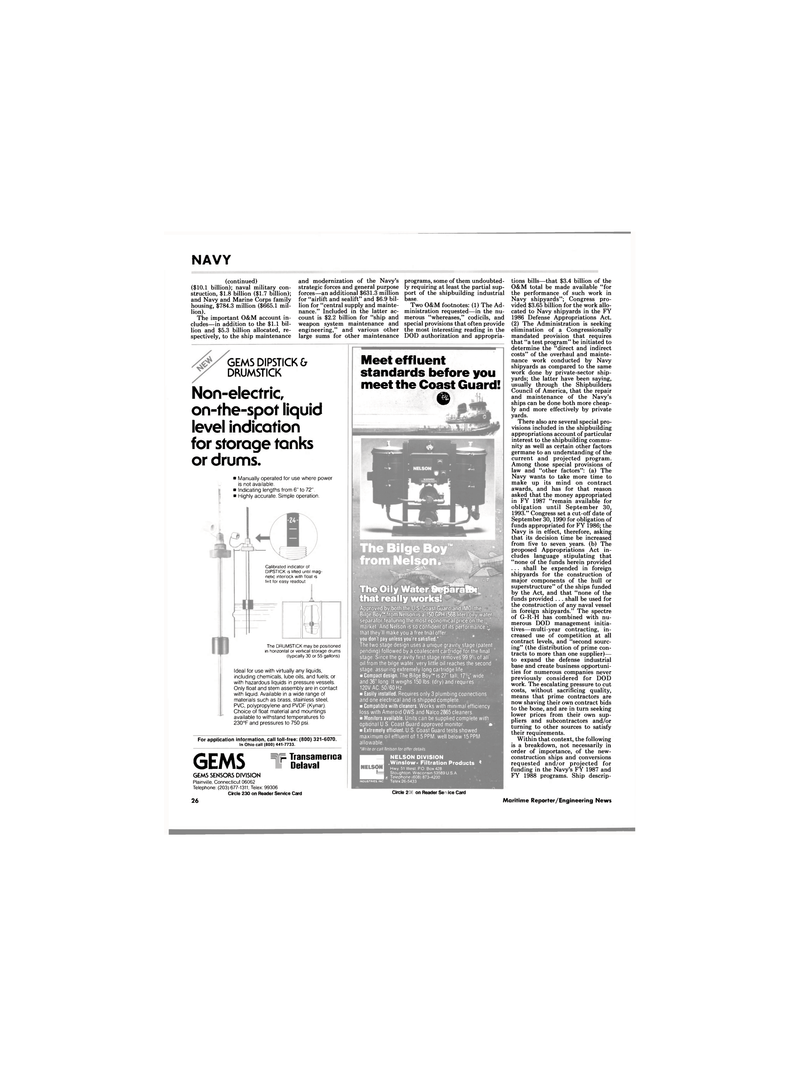
Page 24: of Maritime Reporter Magazine (March 1986)
Read this page in Pdf, Flash or Html5 edition of March 1986 Maritime Reporter Magazine
NAVY (continued) ($10.1 billion); naval military con- struction, $1.8 billion ($1.7 billion); and Navy and Marine Corps family housing, $784.3 million ($665.1 mil- lion).
The important O&M account in- cludes—in addition to the $1.1 bil- lion and $5.3 billion allocated, re- spectively, to the ship maintenance and modernization of the Navy's strategic forces and general purpose forces—an additional $631.3 million for "airlift and sealift" and $6.9 bil- lion for "central supply and mainte- nance." Included in the latter ac- count is $2.2 billion for "ship and weapon system maintenance and engineering," and various other large sums for other maintenance programs, some of them undoubted- ly requiring at least the partial sup- port of the shipbuilding industrial bflSG
Two O&M footnotes: (1) The Ad- ministration requested—in the nu- merous "whereases," codicils, and special provisions that often provide the most interesting reading in the
DOD authorization and appropria-
GEMS DIPSTICK & DRUMSTICK
Non-electric, on-the-spot liquid level indication for storage tanks or drums. • Manually operated for use where power is not available. • Indicating lengths from 6" to 72". • Highly accurate. Simple operation.
Calibrated indicator of
DIPSTICK 5 lifted until mag- netic interlock with float is felt for easy readout
The DRUMSTICK may be positioned in horizontal or vertical storage drums (typically 30 or 55 gallons).
Ideal for use with virtually any liquids, including chemicals, lube oils, and fuels; or with hazardous liquids in pressure vessels.
Only float and stem assembly are in contact with liquid. Available in a wide range of materials such as brass, stainless steel,
PVC, polypropylene and PVDF (Kynar).
Choice of float material and mountings available to withstand temperatures to 230°F and pressures to 750 psi.
For application information, call toll-free: (800) 321-6070.
In Ohio call (800) 441-7733.
GEMS P Transamerica Delaval
GEMS SENSORS DIVISION
Plainville, Connecticut 06062
Telephone: (203) 677-1311; Telex: 99306
Circle 230 on Reader Service Card
Meet effluent standards before you meet the Coast Guard! ©
The Bilge Boy™ from Nelson. _ a - *m > •
The Oily Water 9eparafbt that really works!
Approved by both the U.S. Coast Guard and IM0, the
Bilge BoyT" from Nelson is a 150 GPH (568 liter) oily water separator featuring the most economical price on the market. And Nelson is so confident of its performance.-,; that they'll make you a free trial offer: you don't pay unless you're satisfied.*
The two stage design uses a unique gravity stage (patent pending) followed by a coalescent cartridge for the final stage. Since the gravity first stage removes 99.9% ot all oil from the bilge water, very little oil reaches the second stage, assuring extremely long cartridge life. • Compact design. The Bilge Boy™ is 27" tall. 17'4" wide and 36" long. It weighs 150 lbs. (dry) and requires 120V AC. 50/60 Hz • Easily installed. Requires only 3 plumbing connections and one electrical and is shipped complete. • Compatible with cleaners. Works with minimal efficiency loss with Ameroid 0WS and Nalco 2865 cleaners. • Monitors available. Units can be supplied complete with optional U.S. Coast Guard approved monitor. • • Extremely efficient. U.S. Coast Guard tests showed maximum oil effluent of 1.5 PPM. well below 15 PPM allowable. 'Write or call Nelson lor offer details B m NELSON DIVISION • .Winslow» Filtration Products * ij Hwy 51 West. PO Box 428
Stoughton. Wisconsin 53589 U S A • g Telephone (608) 873-4200
INDUSTRIES INC Telex 26-5433 Circle 237 on Reader Sen/ice Card tions bills—that $3.4 billion of the
O&M total be made available "for the performance of such work in
Navy shipyards"; Congress pro- vided $3.65 billion for the work allo- cated to Navy shipyards in the FY 1986 Defense Appropriations Act. (2) The Administration is seeking elimination of a Congressionally mandated provision that requires that "a test program" be initiated to determine the "direct and indirect costs" of the overhaul and mainte- nance work conducted by Navy shipyards as compared to the same work done by private-sector ship- yards; the latter have been saying, usually through the Shipbuilders
Council of America, that the repair and maintenance of the Navy's ships can be done both more cheap- ly and more effectively by private yards.
There also are several special pro- visions included in the shipbuilding appropriations account of particular interest to the shipbuilding commu- nity as well as certain other factors germane to an understanding of the current and projected program.
Among those special provisions of law and "other factors": (a) The
Navy wants to take more time to make up its mind on contract awards, and has for that reason asked that the money appropriated in FY 1987 "remain available for obligation until September 30, 1993." Congress set a cut-off date of
September 30,1990 for obligation of funds appropriated for FY 1986; the
Navy is in effect, therefore, asking that its decision time be increased from five to seven years, (b) The proposed Appropriations Act in- cludes language stipulating that "none of the funds herein provided ... shall be expended in foreign shipyards for the construction of major components of the hull or superstructure" of the ships funded by the Act, and that "none of the funds provided ... shall be used for the construction of any naval vessel in foreign shipyards." The spectre of G-R-H has combined with nu- merous DOD management initia- tives—multi-year contracting, in- creased use of competition at all contract levels, and "second sourc- ing" (the distribution of prime con- tracts to more than one supplier)— to expand the defense industrial base and create business opportuni- ties for numerous companies never previously considered for DOD work. The escalating pressure to cut costs, without sacrificing quality, means that prime contractors are now shaving their own contract bids to the bone, and are in turn seeking lower prices from their own sup- pliers and subcontractors and/or turning to other sources to satisfy their requirements.
Within that context, the following is a breakdown, not necessarily in order of importance, of the new- construction ships and conversions requested and/or projected for funding in the Navy's FY 1987 and
FY 1988 programs. Ship descrip- 26 Maritime Reporter/Engineering News

 23
23

 25
25
